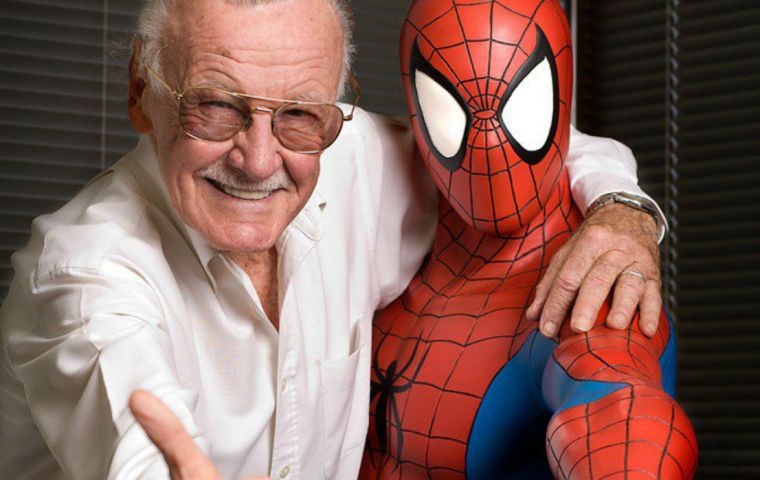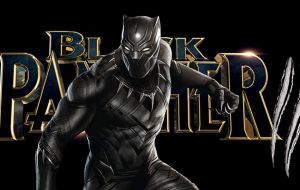MercoPress. South Atlantic News Agency
Genius creator of Spider-Man, the Fantastic Four, Hulk dies at 95
 As the top writer at Marvel Comics and later as its publisher, Lee was widely considered the architect of the contemporary comic book
As the top writer at Marvel Comics and later as its publisher, Lee was widely considered the architect of the contemporary comic book  Millions responded to the unlikely mix and his creations such as Spider-Man, Hulk and X-Men went on to become stars of blockbuster films
Millions responded to the unlikely mix and his creations such as Spider-Man, Hulk and X-Men went on to become stars of blockbuster films  Recent projects range from the films “Black Panther” and “Doctor Strange” to such TV series as “Agents of S.H.I.E.L.D” and “Guardians of the Galaxy”
Recent projects range from the films “Black Panther” and “Doctor Strange” to such TV series as “Agents of S.H.I.E.L.D” and “Guardians of the Galaxy” Stan Lee, the creative dynamo who revolutionized the comic book and helped make billions for Hollywood by introducing human frailties in superheroes such as Spider-Man, the Fantastic Four and the Incredible Hulk, died on Monday. He was 95.
As the top writer at Marvel Comics and later as its publisher, Lee was widely considered the architect of the contemporary comic book. He revived the industry in the 1960s by offering the costumes and action craved by younger readers while insisting on sophisticated plots, college-level dialogue, satire, science fiction, even philosophy.
Millions responded to the unlikely mix of realistic fantasy, and many of his characters, including Spider-Man, the Hulk and X-Men went on to become stars of blockbuster films. Recent projects he helped make possible range from the films “Black Panther” and “Doctor Strange” to such TV series as “Agents of S.H.I.E.L.D” and “Guardians of the Galaxy.”
“I think everybody loves things that are bigger than life. … I think of them as fairy tales for grown-ups,” he said in a 2006 interview. “We all grew up with giants and ogres and witches. Well, you get a little bit older and you’re too old to read fairy tales. But I don’t think you ever outgrow your love for those kind of things, things that are bigger than life and magical and very imaginative.”
Lee considered the comic-book medium an art form and he was prolific: By some accounts, he came up with a new comic book every day for 10 years.
“I wrote so many I don’t even know. I wrote either hundreds or thousands of them” he said in 2006. He hit his stride in the 1960s when he brought the Fantastic Four, the Hulk, Spider-Man, Iron Man and numerous others to life.
“It was like there was something in the air. I couldn’t do anything wrong,” he recalled.
His heroes, meanwhile, were a far cry from virtuous do-gooders such as rival DC Comics’ Superman.
The Fantastic Four fought with each other. Spider-Man was goaded into superhero work by his alter ego, Peter Parker, who suffered from unrequited crushes, money problems and dandruff. The Silver Surfer, an alien doomed to wander Earth’s atmosphere, waxed about the woeful nature of man. The Hulk was marked by self-loathing. Daredevil was blind and Iron Man had a weak heart.
“The beauty of Stan Lee’s characters is that they were characters first and superheroes next,” Jeff Kline, executive producer of the “Men in Black” animated television series, told The Blade of Toledo, Ohio, in 1998.
Some of Lee’s creations became symbols of social change — the inner turmoil of Spider-Man represented ’60s America, for example, while The Black Panther and The Savage She-Hulk mirrored the travails of minorities and women.
Lee scripted most of Marvel’s superhero comics himself during the ’60s, including the Avengers and the X-Men, two of the most enduring. In 1972, he became Marvel’s publisher and editorial director; four years later, 72 million copies of Spider-Man were sold.
“He’s become our Mickey Mouse,” he once said of the masked, web-crawling crusader.
Lee also published several books, including “The Superhero Women” in 1977 and “How to Draw Comics the Marvel Way” the following year, when he was named publisher of the year by the Periodical and Book Association of America.
CBS turned the Hulk into a successful TV series, with Bill Bixby and Lou Ferrigno portraying the doomed scientist from 1978-82. A Spider-Man series ran briefly in 1978. Both characters were featured in animated TV series as well.
The first big-budget movie based on Lee’s characters, “X-Men,” was a smash in 2000, earning more than US$ 130 million at North American theaters. “Spider-Man” did even better, taking in more than US$ 400 million in 2002.
Stanley Martin Lieber was born Dec. 28, 1922, in New York. He grew up a fan of “Hardy Boys” adventure books and Errol Flynn movies, and got a job at Timely Comics after graduating from high school.
Within a few months, the editor and art director quit, leaving the 17-year-old Lee with creative control over the company, which grew and was renamed Atlas Comics and, finally, Marvel. Lieber changed his name, thinking Lee would be used for “silly little comics” and his real name would be reserved for novels.
His early work largely reflected popular movies — westerns, crime dramas, romance, whatever was the rage at the time. He worked for about 50 cents per page.
After a stint in the Army during World War II, writing for training films, he was back at Marvel to begin a long and admittedly boring run of assembly line comic book production.




Top Comments
Disclaimer & comment rulesCommenting for this story is now closed.
If you have a Facebook account, become a fan and comment on our Facebook Page!